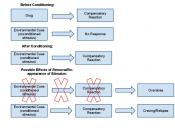Classical Conditioning
Classical conditioning occurs when a stimulus that elicits a response is paired with another stimulus that initially does not response on its own.
Overtime, this second stimulus causes a similar response because it is associated with the first stimulus.
This phenomenon was first demonstrated by Ivan Pavlov's" dog experiments" when doing research on a digestion of animals.
- Pavlov induced classical conditioning learning by pairing a neutral stimulus (a bell) with a stimulus known to cause a salivation response in dogs (he squired dried meat powder into the mouths)
- The powder was an unconditioned stimulus (UCS) because it was naturally capable of causing a response.
- Overtime, the bell become a conditioned response (CS). It did not initially cause salivation, but the dogs learned to associate the bell with the meat powder and begin to salivate at the sound of bell only.
- The drooling of these canine consumers over a sound, now linked to feeding time, was a conditioned response (CR).
Classical conditioning can have similar effects for more complex reactions (such as in automatically using credit card for purchase)
Conditioning effects are more likely to occur after the conditioned stimuli (CS) and unconditioned stimuli (UCS) have been paired a number of times (repetition). Ad campaigns are often repeated. Repeition prevent decay.
Applications to marketing practice:
Many marketing strategies focus on the establishment of associations between stimuli and responses. Examples would be:
- Distinctive brand image
- Linkage between a product and an underlying need
- Brand equity where a brand has a strong positive association in a consumer's memory and commands lots of loyalty as a result
- Repetition can be valuable, however, too much repetition results in advertising wear out
Advertisments often pair a product with a positive stimulus to create a desirable...



OKay essay
Terrible Format...Check it and resubmit it its really hard to read it.
0 out of 0 people found this comment useful.